Monday, 9 June 2014: Montpellier, dinner with Sunny
Written 21 June
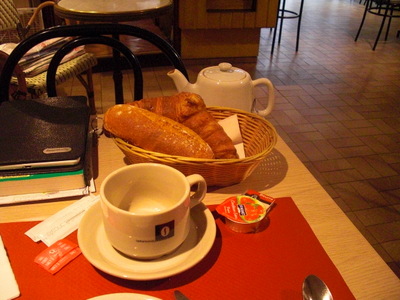
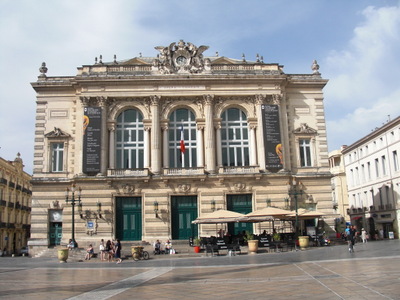 We were up and out surprisingly early Monday morning, considering how long the previous day had been. The hotel was of the sort where they take your hot-drink order (tea in my case) and bring you a set breakfast (in this case, a croissant, a bread bun, strawberry jam, and butter; entirely adequate except that one pat of butter was not enough).
We were up and out surprisingly early Monday morning, considering how long the previous day had been. The hotel was of the sort where they take your hot-drink order (tea in my case) and bring you a set breakfast (in this case, a croissant, a bread bun, strawberry jam, and butter; entirely adequate except that one pat of butter was not enough).
After breakfast, we checked out of the hotel but left our luggage there and set off as usual for the Office de Tourisme, at the foot of the Place de la Comédie, opposite the Comédie itself, shown at the right in its day-time mode. As we strolled up our street into the place, David said, you know it's pretty quiet around here for a Monday morning.
Sure enough, when we got to the office, it was closed, even though, but its posted weekday hours, it should be open. David scanned the very quiet place and hypothesized that it must be another "jour férié," a national holiday. If that was right, then the office should open in half an hour, so we looked around for something to do in the meantime. The little white train was parked nearby, but was not in operation; it's sign said that the first circuit would be at 11 a.m., so we noted that for later.
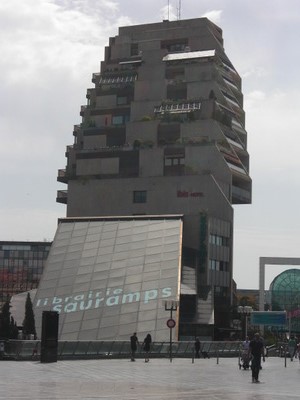
 The Place de la Comédie is a huge, oblong open space with the Comédie itself at one end, the Office de Tourisme at the other, and two axes leading diagonally away from it, one on each side of the Office de Tourisme. The one to the right (with your back to the Comédie) is the entrance to a huge shopping mall called the Polygon; beyond that, still along the axis, is a modern development of office and residential buildings, called the Antigone, whose buildings form interesting geometric shapes. At the left is a photo of a strange building, just at the beginning of that axis, called the Triangle (and, yes, its footprint is trangular). The apartments up there, with broad terraces overlooking the Place de la Comédie, must cost the earth! The broad glass shed roof at its foot is a bookstore, and the green glass arch at the lower right is the entrance to the Polygon.
The Place de la Comédie is a huge, oblong open space with the Comédie itself at one end, the Office de Tourisme at the other, and two axes leading diagonally away from it, one on each side of the Office de Tourisme. The one to the right (with your back to the Comédie) is the entrance to a huge shopping mall called the Polygon; beyond that, still along the axis, is a modern development of office and residential buildings, called the Antigone, whose buildings form interesting geometric shapes. At the left is a photo of a strange building, just at the beginning of that axis, called the Triangle (and, yes, its footprint is trangular). The apartments up there, with broad terraces overlooking the Place de la Comédie, must cost the earth! The broad glass shed roof at its foot is a bookstore, and the green glass arch at the lower right is the entrance to the Polygon.
The Michelin green guide showed a viewpoint overlooking the Antigone from the back of the Polygon, so we headed that way. Never found the overlook, though; perhaps it's inside one of the large department stores at the back of the Polygon, but they were still closed.
Having struck out there, we tried the other axis, to the left of the Office de Tourisme, which is called the esplanade, shown at the right above. It's a long, tree-shaded pedestrian avenue that leads eventually to a sort of Civic Center called the Corum, but we didnt' walk that far. We did go far enough to locate the Musée Fabre, one of the largest art museums in France. The green guide revealed that it was closed on Mondays (drat); all over France, national museums (like the Louvre) are closed on Tuesdays, and city museums (like the Carnavalet in Paris and the Fabre in Montpellier) are closed on Mondays. It was closed when we walked by, but it was early yet, and we held out hope that it might be open because of the holiday.
When our stroll brought us back to the Office de Tourisme, we signed up for the audioguided walking tour of the old town (because the personally guided tours were already booked up through Wednesday; David was really annoyed that we had to leave a deposit of 240 euros for two audioguides; most places just ask you to leave a driver's license or other ID) and verified that the Fabre was indeed closed. The clerk looked at me like I was nuts when I asked what holiday it was—Pentacost, of course!
You can see the whole layout of the Place, the two axes, etc. really well on the Google aerial view. In fact, you can see the little white train, parked at its terminal just in front of the Office de Tourisme!
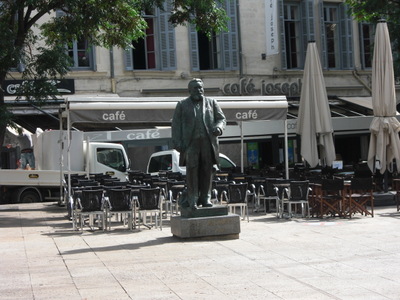
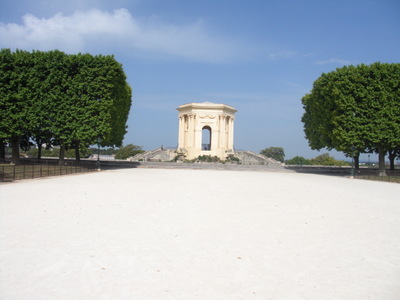 As we started out to begin our walking tour, we saw that, although it was only 9:54 a.m., the little white train was loaded and about to start! We hurried over, found one bench still available, and promised to pay the fare at the end of the ride; perfect timing. We're pretty sure the special 10:00 a.m. circuit was by special arrangement with a bus tour, but the driver wasn't averse to gaining a couple of extra fares, since he had room.
As we started out to begin our walking tour, we saw that, although it was only 9:54 a.m., the little white train was loaded and about to start! We hurried over, found one bench still available, and promised to pay the fare at the end of the ride; perfect timing. We're pretty sure the special 10:00 a.m. circuit was by special arrangement with a bus tour, but the driver wasn't averse to gaining a couple of extra fares, since he had room.
As usual, the little train provided a good overview of what to see. At the right is, of course, Jean Jaurès, in the Place Jean Jaurès, in the middle of the old town. The old town is right up against both the full length of the Place de la Comédie and the full length of the esplanade.
The train made an excursion out of the far side of the old town to take us through the Place Royal de la Peyrou, which lies along yet a third axis, at right angles to the esplanade but not intersecting with it. The Place Royal is marked by the obligatory statue of Louis XIV, is planted with huge old southern magnolias (which were in bloom at the time; the train's narration revealed that the genus is named for a botanist named Magnol, who was a native of Montpellier—I had no idea), and ends at the "water tower," the little white archway shown at the right. I'm pretty sure that the archway itself is not the water tower, which I think is actually built into the hill. The water tower is (or at least was until surprisingly recently) by an arrow-straight elevated 19th-century aqueduct modeled on the Pont du Gard. We never got that far on this trip, but we saw it when we visited Jean-Louis Martin and Sylvie Blangy back when Sunny (a pseudonym) was about 4 years old.
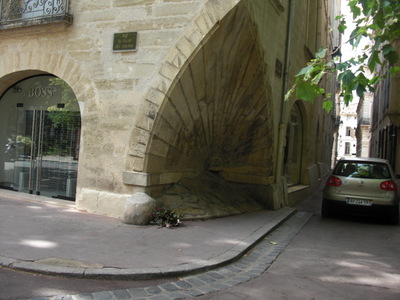
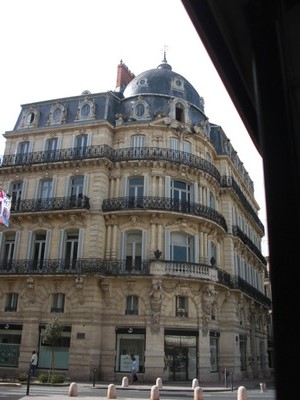 Back in the old town, the narration (a tape this time rather than live commentary by the driver) pointed out the "house of the shell," named for this elegant scallop-shell shaped alcove carved into its corner. The alcove is not just decorative; it was intended to minimize scrapes between that corner and horse-drawn carriages as they negotiated the tight corners and narrow streets. It serves the same purpose today with cars and the little white train.
Back in the old town, the narration (a tape this time rather than live commentary by the driver) pointed out the "house of the shell," named for this elegant scallop-shell shaped alcove carved into its corner. The alcove is not just decorative; it was intended to minimize scrapes between that corner and horse-drawn carriages as they negotiated the tight corners and narrow streets. It serves the same purpose today with cars and the little white train.
It also pointed out the building, shown at the right, that was used as the hotel in one of our favorite French movies, l'Emmerdeur (in English, A Pain in the A——), starring Lino Ventura and Jacques Brel. Ventura plays a hit man trying to set up for an assassination in which he will shoot someone from a hotel window. Brel's character is a needy, suicidal loser who latches onto the hit man, who feels obliged to help him lest he jump from the hotel window and draw undue police attention. Brel's character is named François Pignon, a name used in a number of films by writer/directory Francis Veber; the best known in the US is the main character in Le Placard (The Closet). I don't think the building is a hotel in real life.
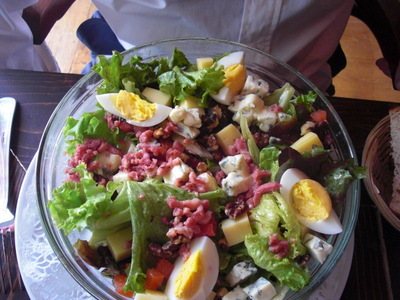
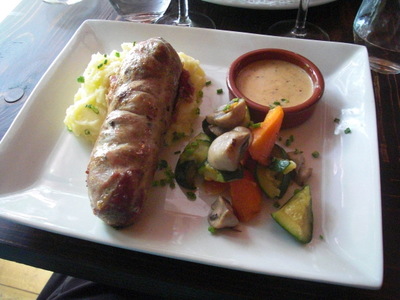 Back at the Place de la Comédie after the train ride and part of the audiotour, we found lunch at a strange little place called "Burger et Blanquette" (Burger and White Veal Stew). The menu was divided into the "burger side" and the "blanquette side, and as far as we could tell, the latter was intended to represent traditional French food. It was, in fact, on the menu, but we didn't order it. The place was decorated with huge, multicolored tissue-paper pompoms, echoed by pastel polka dots on the menu.
Back at the Place de la Comédie after the train ride and part of the audiotour, we found lunch at a strange little place called "Burger et Blanquette" (Burger and White Veal Stew). The menu was divided into the "burger side" and the "blanquette side, and as far as we could tell, the latter was intended to represent traditional French food. It was, in fact, on the menu, but we didn't order it. The place was decorated with huge, multicolored tissue-paper pompoms, echoed by pastel polka dots on the menu.
David had the "peasant salad," with tomatoes, walnuts, eggs, lardons, and cheese. For just 90 eurocents more, I had a "veritable andouillette de Troyes AAAAA," the very best grade of my favorite andouillette (tripe sausage). It, its mild mustard sauce, and its accompanying mashed potatoes were superb. The sautéed veggies were perfectly okay.
Items on the"burger side" of the menu were mostly served on home-made "pain buns" ("buns" bread) and ranged from the "classic" (burger, cheddar, lettuce, tomato, onions, ketchup) to the "Roman" (burger, mozzarella, country ham, gorgonzola cream, hash brown, roasted tomatoes, lettuce, onions) and covered many points in between. The "Scandinavian" (like a couple of others) substuted pancakes (yes, real American-style pancakes; I saw them passing our table) for the bun and contained fresh and smoked salmon, dill cream, lettuce, and onions. No mention was made of a burger, but it may have been in there. The "terroir" was served on a bun and contained foie gras, hash browns, duck confit, lettuce, onions, and (!) ketchup. You could also get one in which the burger was uncooked.
We were the only people sitting inside (just inside the front door), and we fell into conversation with the owner when he came by to ask if we wouldn't prefer sitting outside on such a nice sunny day (we always have to explain to French folks that we're from north Florida; we've had it up to here with sunshine; see the surgical scars?). It turns out that the place had only been open for three days (it's one of two, both in Montpellier); the guy the owner had just had lunch with at the next table (just outside the front door) was the joiner who had done all the wonderful woodwork on the interior. The owner had just signed off on the completed work, and the joiner was due to leave tomorrow.
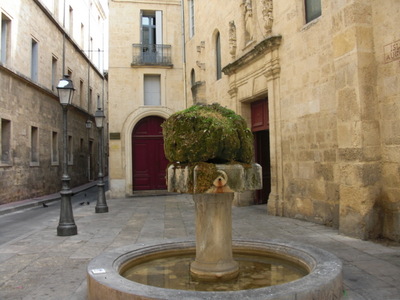
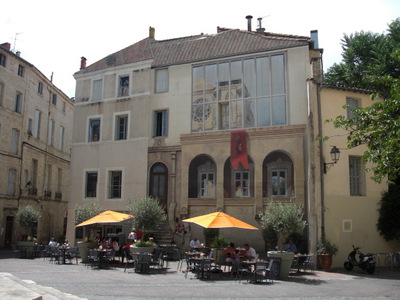 WE finished up more of the audiotour after lunch. It included many places we'd already done quick drive-by's of on the train but of course provided much more information. Neither of the tours mentioned this fountain, although we saw two like it. It seems to be another of those warm-water fountains we saw a couple of in Aix-en-Provence last year; they steam quietly in winter, and plants stay green on them all year round.
WE finished up more of the audiotour after lunch. It included many places we'd already done quick drive-by's of on the train but of course provided much more information. Neither of the tours mentioned this fountain, although we saw two like it. It seems to be another of those warm-water fountains we saw a couple of in Aix-en-Provence last year; they steam quietly in winter, and plants stay green on them all year round.
Something we hadn't seen on the train was this amazing trompe l'oeuil wall. The little potted olive trees, the café tables, and the people sitting at them are real, but everything else is painted, including the red banner, the young people sitting on the steps, all the doors and windows, and even the wonderful studio windows at the top and the reflection of the church in them (although the real church was in fact behind me as I took the photo and would have been reflected there if the windows were real.

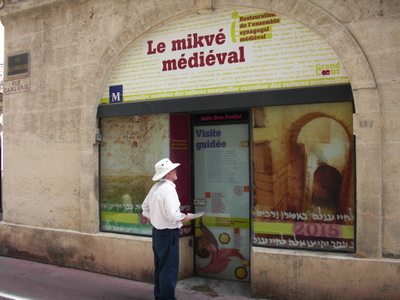 This narrow view of the church is the best we could do. Nowhere else could you get even a fraction of its full height into the frame, even though it wasn't that large; it was just crowded.
This narrow view of the church is the best we could do. Nowhere else could you get even a fraction of its full height into the frame, even though it wasn't that large; it was just crowded.
Something the audioguide covered but he train didn't was the oldest mikve in Europe (at the right), dating from the middle ages. Apparently when it's open, you can tour a limited portin of it, but it was closed that day (for Pentacost?!).
Montpellier also has the oldest med school in Europe, which is still in operation and still well thought of. The ornate building housing its original surgical amphitheater is on both tours. It's famous for its tall, open cupola, where cadavers were suspended when dissections were not in progress. The Jewish population of Montpellier was swelled when Jews fleeing the muslim empires of North Africa settled there, and the scholars of that community were the first to translate the works of Ibn Rushd (known in the western world as AverroŽs) into European languages, putting the local med school on the cutting edge of medical knowledge of the time.
When our feet were thoroughly tired, we returned the audioguides (getting our 240 euros back!), went back to the hotel for our luggage, wheeled it across the place to the parking garage, and loaded up for the trip to our final hotel, which was chosen to be (a) cheap and (b) very near the airport (3 min, acording to their advertising). The GPS had never heard of the hotel or the street it was on (in a brand new industrial development on the outskirts of the airport), so we decided to wing it on maps and airport signs until we could pick up the written directions I had copied from the "FastHotel" website.
Surprisingly, it worked perfectly. When we left the garage, we merged back into traffic in the tunnel, so we had no choice of direction. The tunnel turned out to continue, underground, the length of the place and to emerge beyond it. AT the time, we had no idea where we were, but within seconds, we were zooming along one side of the Antigone, which was absolutely unmistakable. Soon we picked up airport signs (as the lady at the hotel had assured us we would) and followed them until I spotted a sign for "Parc Expo Zone Frejorgue Est," which is where the hotel was supposed to be. Getting there was an adventure, as the road was not really finished. The warning sign said "Chaussée déformée (nids de poule)"; the first means "rough road," and I was delighted to learn from the second that "hens' nests" means "really deep potholes." I love French idioms.
The FastHotel was actually a motel, in the sense that each room had its own outdoor entrance. We opted for rooms on the ground floor, as there was no elevator. Reception was deserted, so we flagged down a couple of chambermaids, busy making up rooms, who turned out to be the owners (mother and daughter would be my guess) and the only staff. They checked us in, cheerfully changed David to a different room when his "no-smoking room" turned out to reek of stale smoke, and arranged for a taxi to take us back into town for our dinner with Sunny and another to take us to the airport in the morning.
We dumped our luggage in the rooms and set off to turn in the rental car at the airport, which we found on only the second try, following the motel lady's directions. We dealt once again with the cheerful folks at Europcar, who were very surprised to hear of our GPS difficulties in Montpellier. Very nice rental office, and very nice airport, only about twice the size of Tallahassee's. Easily caught a taxi back to the motel, where we chilled out until time to head to town for dinner.
Our driver, from "Oxygen" Taxis, picked us up promptly and headed for Montpellier. He explained that the place we were going (Chez Boris) was in the pedestrian zone of the old town but that he could drop us nearby and pick us up again afterward at the same place. We explained that we had no cell phone and would have to depend on the restaurant to call a taxi for us after dinner—the restaurant might have its own preferred taxi company, so we couldn't guarantee it, but we took his number anyway. Strangely, the driver insisted we not yet pay him for the trip; even if we took a different taxi back to the hotel, he would be picking us up in the morning for the trip to the airport, and we could pay him the whole thing then!
The spot where he dropped us turned out to be a good 10-minute hike from the restaurant, across the Place de la Comédie from it, near our ill-fated cul-de-sac. We then turned the walk into a 20-min one by overshooting the restaurant on the first pass. We finally got there about 2 minutes after the appointed hour, and as we approached it, we could see that a young woman was waiting outside it. Seconds before we got there, though, a second young woman (who turned out to be Sunny) arrived and addressed herself to the first one (who turned out to be our waitress), so we weren't really late. Also, a car was parked about 20 feet from our outdoor table, so how pedestrian could this zone be?
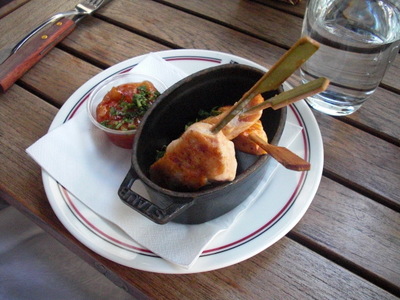
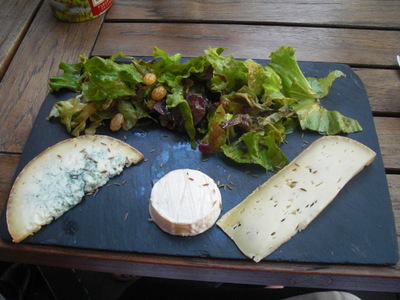 Anyway, once we found the restaurant and connected with Sunny, things went very well.
Anyway, once we found the restaurant and connected with Sunny, things went very well.
First course, Sunny: A plain salad.
First course, David: Indonesian-spiced chicken, grilled on little skewers, with a spicy dipping sauce.
First course, me: Cheese—unusual to find cheese as an appetizer in a French restaurant! The cheese are, left to right, fourme de Montbrison (a blue), cabécou (a chevre), and aged Cantal (a gruyère-ish sort of thing). The little yellowish things in the salad are golden raisins.
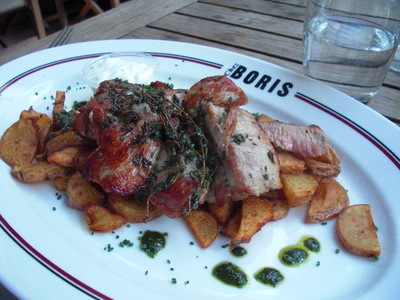
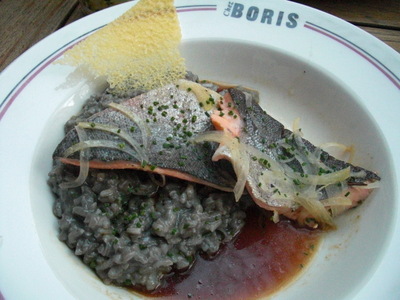 Main course, David and Sunny: Pork grilled with thyme; sliced fried potatoes on the side.
Main course, David and Sunny: Pork grilled with thyme; sliced fried potatoes on the side.
Main course, me: Poached filet of trout (which turned out to be salmon trout) with "risotto of the sea" (which turned out to be squid-ink risotto). Very good, but the dish reinforced my puzzlement that anyone should prefer poached fish. As my readers know, I'm an ardent fan of Mr. Maillard and his browning reactions, so I tend to prefer my fish (and meat) fried, broiled, grilled, roasted or otherwise browned.
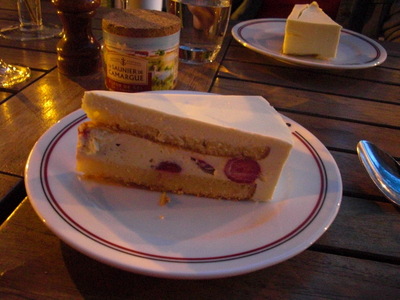
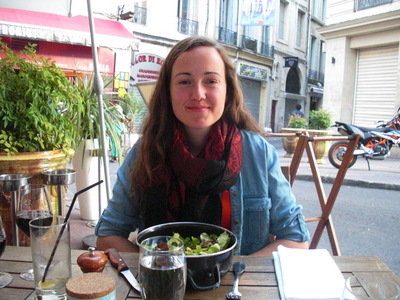 Dessert, all: A "fraisier" of Mara des Bois strawberries—that is, two layers of cake separated (and topped in this case by a layer of gelled cream studied with large chunks of fresh strawberries. Excellent.
Dessert, all: A "fraisier" of Mara des Bois strawberries—that is, two layers of cake separated (and topped in this case by a layer of gelled cream studied with large chunks of fresh strawberries. Excellent.
And here's Sunny, with her plain salad. She had done yeoman service this weekend, hosting her parents' friends. She was just back the day before from a study trip to Spain with her agronomy classmates and had spent the remainder of Sunday and Monday morning hosting another visitor. Sunday afternoon, she had driven that visitor to the train station, driven home, left the car, and hopped on her bike to come meet us! When we told her the story of the taxi, she volunteered to call him for us (she does have a cell phone) and to direct him to pick us up at the rotary we could plainly see, less than a block from the restaurant. That worked perfectly; we strolled up to the rotary, chatted until the taxi showed up, and were whisked back to our hotel is short order. Thanks, Sunny!
Back at the hotel, the taxi driver still refused payment, deferring it to the trip to the airport. That made me nervous; was he going to wait until we were in the middle of airport traffic, with a plane to catch, and present us with an exorbitant bill? I asked the hotel staff about it, but they assured us that they had never had any trouble with Oxygen Taxis. They were the only ones who always showed up on time, and the hotel had heard no complaints of any kind, so we were somewhat reassured.
previous entry
List of Entries
next entry

 We were up and out surprisingly early Monday morning, considering how long the previous day had been. The hotel was of the sort where they take your hot-drink order (tea in my case) and bring you a set breakfast (in this case, a croissant, a bread bun, strawberry jam, and butter; entirely adequate except that one pat of butter was not enough).
We were up and out surprisingly early Monday morning, considering how long the previous day had been. The hotel was of the sort where they take your hot-drink order (tea in my case) and bring you a set breakfast (in this case, a croissant, a bread bun, strawberry jam, and butter; entirely adequate except that one pat of butter was not enough).
 The Place de la Comédie is a huge, oblong open space with the Comédie itself at one end, the Office de Tourisme at the other, and two axes leading diagonally away from it, one on each side of the Office de Tourisme. The one to the right (with your back to the Comédie) is the entrance to a huge shopping mall called the Polygon; beyond that, still along the axis, is a modern development of office and residential buildings, called the Antigone, whose buildings form interesting geometric shapes. At the left is a photo of a strange building, just at the beginning of that axis, called the Triangle (and, yes, its footprint is trangular). The apartments up there, with broad terraces overlooking the Place de la Comédie, must cost the earth! The broad glass shed roof at its foot is a bookstore, and the green glass arch at the lower right is the entrance to the Polygon.
The Place de la Comédie is a huge, oblong open space with the Comédie itself at one end, the Office de Tourisme at the other, and two axes leading diagonally away from it, one on each side of the Office de Tourisme. The one to the right (with your back to the Comédie) is the entrance to a huge shopping mall called the Polygon; beyond that, still along the axis, is a modern development of office and residential buildings, called the Antigone, whose buildings form interesting geometric shapes. At the left is a photo of a strange building, just at the beginning of that axis, called the Triangle (and, yes, its footprint is trangular). The apartments up there, with broad terraces overlooking the Place de la Comédie, must cost the earth! The broad glass shed roof at its foot is a bookstore, and the green glass arch at the lower right is the entrance to the Polygon.
 As we started out to begin our walking tour, we saw that, although it was only 9:54 a.m., the little white train was loaded and about to start! We hurried over, found one bench still available, and promised to pay the fare at the end of the ride; perfect timing. We're pretty sure the special 10:00 a.m. circuit was by special arrangement with a bus tour, but the driver wasn't averse to gaining a couple of extra fares, since he had room.
As we started out to begin our walking tour, we saw that, although it was only 9:54 a.m., the little white train was loaded and about to start! We hurried over, found one bench still available, and promised to pay the fare at the end of the ride; perfect timing. We're pretty sure the special 10:00 a.m. circuit was by special arrangement with a bus tour, but the driver wasn't averse to gaining a couple of extra fares, since he had room.
 Back in the old town, the narration (a tape this time rather than live commentary by the driver) pointed out the "house of the shell," named for this elegant scallop-shell shaped alcove carved into its corner. The alcove is not just decorative; it was intended to minimize scrapes between that corner and horse-drawn carriages as they negotiated the tight corners and narrow streets. It serves the same purpose today with cars and the little white train.
Back in the old town, the narration (a tape this time rather than live commentary by the driver) pointed out the "house of the shell," named for this elegant scallop-shell shaped alcove carved into its corner. The alcove is not just decorative; it was intended to minimize scrapes between that corner and horse-drawn carriages as they negotiated the tight corners and narrow streets. It serves the same purpose today with cars and the little white train.
 Back at the Place de la Comédie after the train ride and part of the audiotour, we found lunch at a strange little place called "Burger et Blanquette" (Burger and White Veal Stew). The menu was divided into the "burger side" and the "blanquette side, and as far as we could tell, the latter was intended to represent traditional French food. It was, in fact, on the menu, but we didn't order it. The place was decorated with huge, multicolored tissue-paper pompoms, echoed by pastel polka dots on the menu.
Back at the Place de la Comédie after the train ride and part of the audiotour, we found lunch at a strange little place called "Burger et Blanquette" (Burger and White Veal Stew). The menu was divided into the "burger side" and the "blanquette side, and as far as we could tell, the latter was intended to represent traditional French food. It was, in fact, on the menu, but we didn't order it. The place was decorated with huge, multicolored tissue-paper pompoms, echoed by pastel polka dots on the menu.
 WE finished up more of the audiotour after lunch. It included many places we'd already done quick drive-by's of on the train but of course provided much more information. Neither of the tours mentioned this fountain, although we saw two like it. It seems to be another of those warm-water fountains we saw a couple of in Aix-en-Provence last year; they steam quietly in winter, and plants stay green on them all year round.
WE finished up more of the audiotour after lunch. It included many places we'd already done quick drive-by's of on the train but of course provided much more information. Neither of the tours mentioned this fountain, although we saw two like it. It seems to be another of those warm-water fountains we saw a couple of in Aix-en-Provence last year; they steam quietly in winter, and plants stay green on them all year round.
 This narrow view of the church is the best we could do. Nowhere else could you get even a fraction of its full height into the frame, even though it wasn't that large; it was just crowded.
This narrow view of the church is the best we could do. Nowhere else could you get even a fraction of its full height into the frame, even though it wasn't that large; it was just crowded.
 Anyway, once we found the restaurant and connected with Sunny, things went very well.
Anyway, once we found the restaurant and connected with Sunny, things went very well.
 Main course, David and Sunny: Pork grilled with thyme; sliced fried potatoes on the side.
Main course, David and Sunny: Pork grilled with thyme; sliced fried potatoes on the side.
 Dessert, all: A "fraisier" of Mara des Bois strawberries—that is, two layers of cake separated (and topped in this case by a layer of gelled cream studied with large chunks of fresh strawberries. Excellent.
Dessert, all: A "fraisier" of Mara des Bois strawberries—that is, two layers of cake separated (and topped in this case by a layer of gelled cream studied with large chunks of fresh strawberries. Excellent.